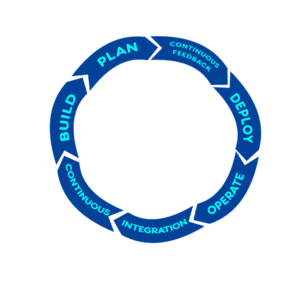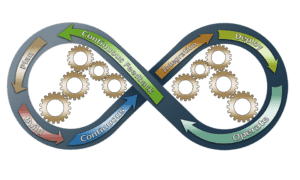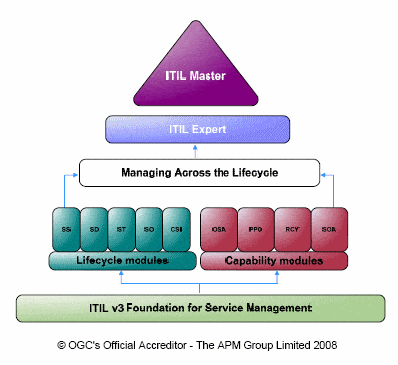What Is ITIL Information Technology Infrastructure Library?

The ITIL Information Technology Infrastructure Library has been growing in popularity because of its universal suitability as a framework for managing information technology (IT) services, including the infrastructure, development, and operations of an IT department.
ITIL–Information Technology Infrastructure Library
In its fullest implementation, ITIL is a perfect complement to – and is perfectly complemented by – Six Sigma and Lean to create more agile and higher quality IT operations. Using Six Sigma techniques like the DMAIC process introduces a more structured engineering approach to ITIL’s framework. Lean thinking promotes continuous improvement and waste reduction into ITIL’s best practices.
ITIL Framework
ITIL itself does not provide methods to identify and target waste, document value streams (as is usually done with Lean), or measure customer satisfaction. Nor is ITIL itself a transformation method used for change management. But ITIL does provide the vocabulary and framework we think of as the process approach advocated by Deming, which is where all process improvements start.
ITIL Starting Point to Best Practices
Implementing an ITIL framework is an excellent starting point for IT organizations looking to evolve toward a best practices oriented state. Six Sigma and Lean can be added to the ITIL framework to help your IT organization achieve continuous improvement and organizational agility.
The ITIL 4 Foundation Book was released February 18, 2019 and ITIL is currently updating from ITIL v3 to ITIL 4 to maintain relevance with current IT best practices. ITIL has now evolved beyond the delivery of services to providing end-to-end value delivery through service relationships.
ITIL 4 Four dimension model
The four dimensions reflect the old 4 P’s of ITIL – people, products, partners, processes. Each component of the SVS should include the four dimensions.
- Organizations and people
- Information and technology products
- Partners and suppliers
- Value streams and processes
ITIL 4 Practices
The well known ITIL v3 processes are now 34 v4 practices that form the ITIL SVS. ITIL v3 service lifecycle has been replaced with the ITIL 4 service value system (SVS) and the service value chain within it. Each ITIL v4 practice correlates with the six activities of the ITIL 4 service value chain.
ITIL 4 service value chain
-
- plan
- improve
- engage
- design and transition
- obtain/build
- deliver and support.
ITIL 4 General management practices
The 14 general management practices.
Note: The old service management focus is now called general management practices.
- Strategy management
- Portfolio management
- Architecture management
- Service financial management
- Workforce and talent management
- Continual improvement (PDCA)
- Measurement and reporting
- Risk management – (see ISO 31000:2018 Risk Management).
- Information security management
- Knowledge management
- Organizational change management
- Project management
- Relationship management
- Supplier management
ITIL 4 Service management practices
ITIL 4 Edition names 17 service management specific practices:
- Business analysis
- Service catalog management
- Service design
- Service level management
- Availability management
- Capacity and performance management
- Service continuity management
- Monitoring and event management
- Service desk
- Incident management
- Service request management – Includes both Request Fulfillment and Access Management of ITIL V3
- Problem management
- Release management – Includes an explanation about releases in waterfall driven environments and DevOps driven organizations.
- Change control – Formerly known as change management.
- Service validation and testing
- Service configuration management
- IT asset management
ITIL 4 Technical management practices
The three technical management practices are:
- Deployment management – In alignment with release management and change control for the administrative activities deployment management carries out all real doing on systems and clouds. Including a list of different approaches of deployment.
- Infrastructure and platform management – It comes with a wide alignment for cloud computing.
- Software development and management
The ITIL 4 certification scheme is aligned with ITIL v3 and has been streamlined to provide clear paths for practitioners to continue their ITIL journey. You can also take the ITIL® V4 “Foundation” exam and receive a nice A4 certificate. You used to also get a lapel pin (Figure 1), but I don’t think they still do that.
The greenish colored pin on the left is the one you receive on passing the ITIL Foundation exam. The Foundation exam is the first step in the ITIL Qualification Scheme (Figure 2). It is followed by two Intermediate exams — for Service Capability and Service Lifecycle — which are, in turn, followed by Expert and Master level designations.
ITIL V3 Processes
ITIL V3 Processes expanded the original ten processes into 27 processes organized into five core areas or books: Service Strategy (included in our IT policies and procedures manual), Service Design, Service Transition, Service Operations, and Continual Service Improvement Processes. The intent is to explain “how” more than just the “what” based approach of V2.
1. SERVICE STRATEGY
- Service Portfolio Management
- Demand Management
- Finance Management (V2)
2. SERVICE DESIGN
- Availability Management (V2)
- Capacity Management (V2)
- IT Service Continuity Management (V2)
- Service Level Management (V2)
- Information Security Management
- Supplier Management
- Service Catalog Management
3. SERVICE TRANSITION PROCESSES
- Change Management (V2)
- Service Asset & Configuration Management (V2)
- Knowledge Management
- Release & Deployment Management (V2)
- Service Validation & Testing
4. SERVICE OPERATIONS FUNCTIONS AND PROCESSES
- Service Desk Management
- Technical Management
- IT Operations Management
- Applications Management
- Event Management
- Incident Management (V2)
- Problem Management (V2)
- Request Fulfillment
- Access Management
5. CONTINUAL SERVICE IMPROVEMENT PROCESSES
- CSI Service Level Management
- Service Measurement & Reporting
- CSI Improvement Process
ITIL V3 Service Management Lifecycle
ITIL V3 processes have expanded to cover the complete service management lifecycle and are closely aligned with ISO 20000. Similar to ITIL but integrating the process-based approach common to ISO standards, ISO 20000 is an international standard that describes best practices for IT service management. ISO/IEC 20000 was published in December, 2005, and replaced BS 15000.
ITIL V2 and ITIL V3
Just like with ISO 9000, the standard evolved out of efforts by the UK government during the 1980’s to model successful organizations and their IT service management approach. Version 3 was released in 2007 and takes a more circular or complete cycle approach than its predecessors, just as ISO 9000 has evolved into a more dynamic, process-based approach. The two have much in common and can be used side-by-side, but there are some ITIL V2 and ITIL V3 Differences.
Differences
The core disciplines of ITIL V2 used to focus on “what” Service Support and Service Delivery should be done. Ten processes tightly defined ITIL V2 around some of the main operational elements of running IT services.
The Ten Original ITIL V2 Processes:
- Finance Management
- Availability Management
- Capacity Management
- IT Service Continuity Management
- Service Level Management
- Change Management
- Service Asset & Configuration Management
- Release & Deployment Management
- Incident Management
- Problem Management
While ITIL provides guidance to service companies, those companies cannot be ITIL-accredited; individuals may be certified as ITIL practitioners. Companies may be accredited to ISO 27000, however, and while ISO 27000 does not require companies to use ITIL rules, company accreditation to the ISO standard is made far easier by implementing ITIL beforehand.


















Very informative and well explained post on ITIL. Thanks for sharing!